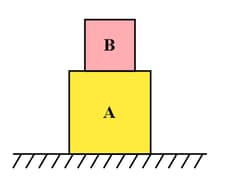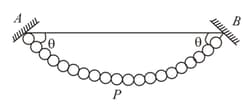Common Forces in Mechanics
Common Forces in Mechanics: Overview
This Topic covers sub-topics such as Frictional Force, Contact Forces, Spring Forces, Normal Reaction Force, Field Forces, Tension in Strings, Hinge Forces, Classification of Forces, Variable Forces, Viscous Forces and, Total Contact Force
Important Questions on Common Forces in Mechanics
A monkey of mass is holding a vertical rope. The rope will not break when a mass of is suspended from it but will break if the mass exceeds . What is the maximum acceleration with which the monkey can climb up along the rope?
A man weighing 80 kg, stands on a weighing scale in a lift which is moving upwards with a uniform acceleration of What would be the reading on the scale?
Two blocks of mass and are suspended from a rigid support by two inextensible wires each of length see figure. The upper wire has negligible mass and the lower wire has a uniform mass of . The whole system of blocks, wires and support has an upward acceleration of . Acceleration due to gravity is .
(i) Find the tension at the mid-point of the lower wire.
(ii) Find the tension at the mid-point of the upper wire.

A man weighing is in a lift moving down with an acceleration of . The force exerted by the floor on him is
A man weighing is in a lift moving down with an acceleration of . The force exerted by the floor on him is
What are field forces? Give two examples.
A force is said to be variable if its magnitude or direction changes with position or time.
Mention the two ways to vary a variable force.
Our shoulder joint is a hinge joint.
Field forces are also called _____ forces or at-a-distance forces.
What is the field force example?
A system of two bodies A and B are placed as shown in figure. How many forces are acting on A and B respectively?

A box of mass starts from rest and slides down an inclined plane metre long and metre high. It is found to move at the bottom at What is the force of friction?
A flexible chain of mass hangs between two fixed points and at the same level. The inclination of the chain with the horizontal at the two points of support is The tension at the mid-point of the chain is :

When a person walks on a surface, the frictional force exerted by the surface on the person is opposite to the direction of motion. True or false?
When walking on ice one should take short steps. Why?
There is a limit beyond which the polishing of a surface increases frictional resistance rather than decreasing it why?
